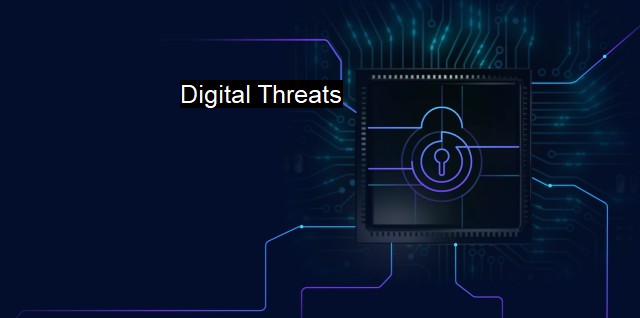What are Digital Threats?
Understanding Cybersecurity and Antivirus: Protecting in a World of Increasingly Sophisticated Digital Threats
Digital threats are potential cyber dangers that harm or disrupt digital devices such as computers, servers, networks, or mobile devices, leading to loss of assets and data. They are malevolent attempts to disrupt or cause harm, unauthorized access or data leaks. digital threats refer to multifaceted cyber-attacks like viruses, malware, hacks, phishing attacks, ransomware, denial-of-service attacks, or other tactics that aim to exploit digital errors, human error, or system vulnerabilities.A significant type of digital threat is powered by malware. A contraction of malicious software, malware is a collective term for viruses, ransomware, worms, and Trojan horses. All these are software programs developed to inflict damage, unauthorized access, and theft of invaluable user data including financial information. Viruses are self-replicating programs that fasten themselves to clean, existing files - spreading in a parasite-like manner across a computer or networked system.
Ransomware is another common digital threat in cyber-security, playing a large part in huge data breaches in recent years. In this type, malware encrypts a user's files, making them inaccessible. The user is then directed to pay a ransom should they wish to regain access to their files. there is never a guarantee that the criminals would indeed live up to their end of the deal once the user pays up.
Worms and Trojan horses also form part of the digital threat matrix. Worms self-replicate without user intervention making them particularly sacrilegious, while Trojan horses masquerade as harmless software till they reach neurological points on the system exploiting user permissions.
Phishing attacks represent another kind of digital threat rampant in the cyber world. These attacks involve deceptive tactics to trick individuals into revealing sensitive information - using enormous amounts of data like login information and potentially causing devastating data leaks. It is a typical digital threat that is aimed at stealing sensitive data and affecting financial temerity.
Denial of Service attacks (DoS) form part of volumetric threats in the digital spectrum. Perpetrators overload network systems with traffic from varying sources to make a machine or network resource unattainable to its intended users. Distributed Denial of Service attacks (DDoS) is another kind of threat with cybercriminals overloading system resources but from multiple infected machines known as a botnet.
In light of raising stakes, cybersecurity’s role is paramount to orchestrate cutting-edge shield against digital threats. While antivirus software methods are prevalent for individual protection, in broad networks and critical invaluable infrastructures, stringent security protocols, firewalls, intrusion detection systems, encryption, and secure codes play influential roles.
Antivirus software helps protect against digital threats particularly directed towards harming or disabling computer systems and stealing user data. They work by preventing, detecting and removing malicious inputs; with regular updates for emerging threats. it's essential to note that antivirus software only forms a part of whats required for a comprehensive cyber-security solution.
As digital realms extend their boundaries every day, cyber threats also evolve. To nip them in the bud, the monitoring and mitigation techniques for handling the digital threats from a cybersecurity perspective need constant work and vigilance. Even as technological advancements continue, the dicey fact remains that cyber hackers are perpetually on the quest to defeat security structures.
Digital threats span a wide-scale, sinister landscape. Organizational behemoths and individuals alike are exposed to them, their dire consequences making cybersecurity and antivirus mechanisms an indispensable shield. The realm of digital threats is dynamic, threatening to create deep imprints across informational and financial veins in this era of relentless digitization. Experts and ordinary people alike must remain vigilant and knowledgeable to avert the disastrous reverberations from the subterranean world of digital threats.

Digital Threats FAQs
What are some common types of digital threats that I should be aware of?
Common types of digital threats include viruses, malware, phishing, ransomware, spyware, and adware.How can I protect my computer from digital threats?
You can protect your computer from digital threats by installing antivirus software, keeping your operating system and programs up-to-date, using strong passwords and two-factor authentication, avoiding suspicious emails and websites, and backing up your important data.What should I do if I think my computer has been infected with a virus or other digital threat?
If you suspect that your computer has been infected, you should immediately disconnect it from the internet and run a full system scan with your antivirus software. If the problem persists, you may need to seek professional help from a cybersecurity expert.Is it safe to download and install free antivirus software?
While some free antivirus software can be effective, it's important to be cautious when downloading and installing it. Always download from a reputable source, and carefully read reviews and user feedback before installing any program on your computer. It's also a good idea to run a virus scan on any downloaded files before opening them.| | A | | | B | | | C | | | D | | | E | | | F | | | G | | | H | | | I | | | J | | | K | | | L | | | M | |
| | N | | | O | | | P | | | Q | | | R | | | S | | | T | | | U | | | V | | | W | | | X | | | Y | | | Z | |
| | 1 | | | 2 | | | 3 | | | 4 | | | 7 | | | 8 | | |||||||